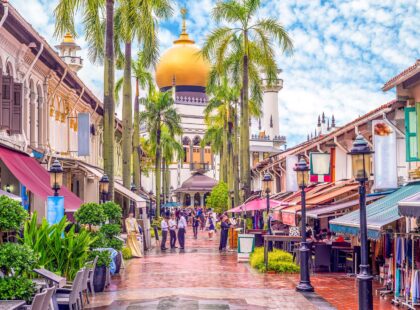
Going for a run – a casual jog or marathon – while you’re abroad is a great way to explore your new surroundings. Cami Ostman, author of Second Wind: One Woman’s Midlife Quest to Run Seven Marathons on Seven Continents, shares tips on training for different terrain.
Going coastal
Newbie marathon runners could do well by starting with a marathon that runs along the shoreline: It tends to come with a flat course and, often, benign weather. Great coastal runs include the Mont Saint-Michel Bay Marathon in France and Gold Coast Airport Marathon in Australia. The latter carries you along the scenic stretch of blue waters and sandy beaches dotted with surfers. Save the best for last by setting aside a few days for lounging by the beach after the race. But before you think about relaxing, you’d need to put in some work in order to enjoy your seaside run:
- Check weather forecasts and keep tabs on the temperature and humidity prior to the race. A coastal race puts you right next or close to the sea in most parts of the course. The conditions may appear ideal, but sometimes the weather can change. In cool weather, the air can be particularly chilly next to the sea, so bring along extra layers to stay warm.
- Make yourself as comfortable as possible. “A coastal race will always take you through the salty air and will most often require you to interact with the wind,” says Ostman, adding that sand in the air is also an issue. “Sunglasses are a must for a coastal race, especially if you wear contact lenses.”
- Check the race route before the race. If it brings you onto the beach, pack gaiters – lightweight sleeves attached to your shoes and affixed around your ankles – to keep the sand out of your shoes.
City routes
The city marathon is the most familiar to urban dwellers. Among the most famous are the six World Marathon Majors, held in major cities such as London, Berlin and Tokyo. Urban marathons zip through some of the major sights in the city itself. To see the five boroughs of the famous city in a fresh way, join the annual New York City Marathon. Keep your wits about you and bear in mind that:
- You may feel comfortable in an urban environment, but stay alert for hazards. “I’ve learned that it’s as important to pay attention to where my feet land in a city as it is on a trail,” says Ostman. “Sidewalks buckle, and potholes appear sometimes out of nowhere.” Also take to heart the information the organisers provide about your specific race. Not all city marathons close the roads to traffic, so be responsible for your own safety.
- Not all urban routes are flat. When preparing for a city marathon, train beyond a flat course by including elevations.
- Whether you’re going for a slow jog through an urban city or participating in a road race, a city course can “offer a terrific chance to do some turbo sightseeing”, says Ostman. During a race in Panama City that brought runners through the ruins of the old section of the town, Ostman made a mental note of locations that she would want to revisit later in her trip.
Running high
Hilly terrain and high-altitude courses are challenging even for the most experienced runners. Popular ones that are fully subscribed to long before the race dates include the Jungfrau Marathon (above) in Switzerland and the Inca Trail Marathon in Peru. The breathtaking views along the routes are a reward in themselves. Here’s how to get in gear – literally and metaphorically – for a run at altitude:
- Train beforehand on routes that wind uphill and down. “Make sure you’ve trained on trails that require you to hop over roots or rocks and to manage uneven terrain. Trail racing uses different muscles than road racing and gives you more opportunities to fall if you don’t watch where you’re going,” Ostman warns.
- Pack suitable gear such as gaiters (to keep gravel and mud from getting into your shoes) and lightweight rain gear (in case of bad weather). Bring your own supply of energy gel and electrolyte drinks, but remember to locate the water points before your run.
- Arrive at your destination a few days before the race to help your body acclimatise to the thin air. “The best way to get through a high-altitude race without getting sick is to stay hydrated and fuelled, as well as to take walking breaks,” says Ostman.
– TEXT BY ROSSARA JAMIL
PHOTO GETTY IMAGES
This article was originally published by Singapore Press Holdings.






